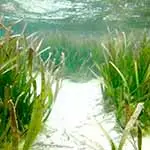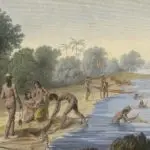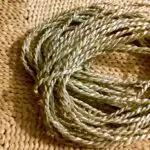CHamoru/Chamorro Seagrass Fishing Nets



Table of Contents
Share This
Fishing was an important part of daily life in the Mariana Islands. Fishing provided food but it also encouraged innovation in making tools to catch different kinds of fish. The CHamorus/Chamorros used different kinds of fishing nets, including surround, gill and hand nets, depending on what they were trying to catch. The nets were often used along with fishing lines made from coconut husk (as sennit) or hibiscus (pago).
The CHamorus often made their fishing nets out of the vascular bundles of fibers from Lo’u, a common seagrass. This seagrass is frequently called turtle grass or eelgrass in English, lo’u in CHamoru, and the scientific name is Enhalus acoroides. The generic CHamoru word for sea plants is chaguan tasi. The blades of this common reef seagrass are often described as straps or tapes.
Lo’u is common throughout the Western Pacific and is able to withstand wave action and tidal currents. They usually grow in shallow, soft muddy substrates or sand flats, and coral reefs. They are unique because they are the only seagrass species whereby pollination occurs at the surface of the water.
In 1719 the German Jesuit Priest Joseph Bonani observed the use of seagrass for fishing nets in Luta (Rota). One hundred years later in 1819 members of the French Freycinet scientific expedition also observed CHamorus using seagrass fishing nets.
Lo’u was used for chenchulu (drag nets) and lagua’ (hand nets) because the fibers were strong and durable. In Yap fishing nets made of Enhalus acoroides were heirlooms and passed from generation to generation. It is reasonable to infer that CHamorus used seagrass for fishing line and cordage for necklaces. Those are common practices among peoples of the Pacific and Indian Oceans.
By Lawrence J. Cunningham, Eric Metzgar, and Cheryl N. Cunningham
Personal communication
- Frank J. Cruz, Horticulturist University of Guam (retired)
- Manny Duenas, President Guam Fishermen’s Co-op Association
- Dr. Marjorie Cushing Falanruw, Biologist
- Associate Professor Joni Quenga Kerr, Science Department, Guam Community College
- Cara Lin, Seagrass and Mangrove Conservation Coordinator, Guam Coral Reef Initiative, Guam Department of Agriculture
- Professor Rosa Salas Palomo, CHamoru Studies Program, University of Guam (retired)
- Professor Dr. Thomas Stolz, Linguist Bremen University, Bremen, Germany
For further reading
Bonani, Fr. José [Joseph]. Letter from Fr. Bonani to Fr. Pettinati, Rota 27 May 1719. Document 1719A. History of Micronesia: A Collection of Source Documents. Vol. 12, Carolinians drift to Guam, 1715-1728. Translated by Rodrigue Lévesque. Québec: Lévesque Publications, 1998.
Cunningham, Lawrence J. Ancient Chamorro Society. Honolulu: Bess Press, 1992.
Falanruw, Margie Cushing. “Seagrass Nets.” Atoll Research Bulletin, No. 364. (1992): 1-12.
Falanruw, Margie Cushing, and L. Hotaling. Life on Guam: Beach Strand. Hagåtña: Department of Education, 1977.
Freycinet, Louis Claude Desaulses de. Uranie et Physicienne Voyage. Paris: Chez Pillet Aîné, 1829.
iNaturalist. “Tape Seagrass (Enhalus acoroides).” Last modified 21 October 2024.
Randall, Richard H., and LG Eldredge. Life in Guam: Coral Reef. Hagåtña: Department of Education, 1977.
Strasser, Ulrike. “Reporting of the Marianas and Their Inhabitants in Early 18th Century Germany: The Jesuit ‘Neue Welt-Bott (New World Messenger) as a Source of Knowledge and Colonial Fantasy.” In 5th Marianas History Conference, 19 – 28 February 2021.
